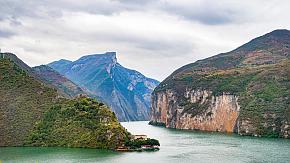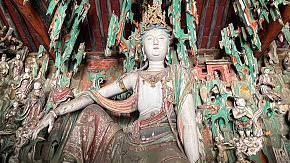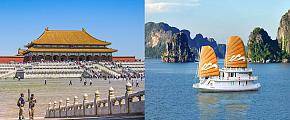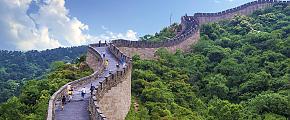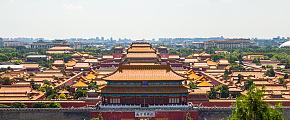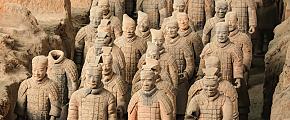10 Best Places in Xi'an, China
From ancient city walls and vibrant Muslim Quarter streets to peaceful temples and museums, every corner tells a story of dynasties past and present charm. Whether you're a history lover or a casual traveler, these top 10 places in Xi’an will take you on an unforgettable journey through time.
Terracotta Army 兵马俑
On March 29, 1974, a couple of farm workers were sent to dig a well on land near a village about 42km / 26 miles to the east of Xi'an. One of the men, Yang Zhifa, later described what happened, saying that after three days of digging, he hit a layer of hard red earth. Breaking through this, Yang discovered what he thought of at first to be an old kiln. Hoping to find some old jars for his own use, he continued digging and eventually unearthed a life-sized statue of what appeared to be a soldier missing its head and one leg. He also found various bronze items which appeared to be weapons. He and some neighbors loaded up three wagon loads of artifacts and hauled them to the nearest museum, where they were recognized as being from the Qin dynasty (221 to 206 BC), founded by Qin Shi Huang, the first emperor of a unified China, whose mausoleum lies nearby. A museum curator and archaeologist, Zhao Kangmin, was sent to investigate the site and realized there could be more, so a full archaeological investigation was set in motion. Over the next years, a huge army of warriors numbering some 8,000 was discovered along with horses, carriages and much more.
 Terracotta Army
Terracotta Army
It was decided to turn the site into a museum and research center, so the locals including Yang, were relocated to a new village. Today, the site covers 16,300 meters² (175,000 sq. ft.) and remains the greatest archaeological finds of the 20th century and one of the greatest ever. Awarded UNESCO World Heritage status in 1987, the site is one of China's top attractions.
There are currently three pits which have been excavated. Pit 1 is the largest, containing around 6,000 soldiers standing battle formation to protect the emperor in the afterlife. Pit 2 features cavalry, archers and infantry units along with war chariots, while Pit 3 contains the highest ranking officers. All three are open to the public.
Each statue is unique with its own facial features and expression, varying hairstyles etc. From the army's uniforms it is possible to discern each soldier's rank. Originally the statues were colorfully painted, but the paint peeled off within minutes of them being exposed to the air. Many of the weapons they carried have also rusted away. It is known that there are many more relics including statues still buried on the site, but the authorities have stopped such work until a means can be found to prevent them from being harmed by exposure to the air.
Nearby is the mausoleum of Qin Shi Huang (秦始皇陵), but it too has been left unexplored for fear of damaging any contents. You can visit this too, but to be honest, all there is to see is a mound of earth.
Opening Times: March 16th to November 15th: 8:30 to 18:00, last ticket sales 17:00; November 16th to March 15th: 8:30 to 17:00, last tickets 16:30. Tickets to the museum and the mausoleum cost 150 RMB (about 21 USD, November 2025 rates) in peak season (March 1st to November 30th) and 120 RMB/17 USD off peak. Children under 1.2 meters / 4 feet tall enter free.
As a popular destination, the site is always busy, but especially so in public holidays (the first weeks of May and October and at the Chinese New Year). Although visitor numbers are now restricted to 65,000 a day, the holidays are best avoided.
Giant Wild Goose Pagoda 大雁塔
An important symbol of Xi'an, the Giant Wild Goose Pagoda can be found in Yanta district in the south of Xi'an. Part of the Buddhist Daci'en Temple (大慈恩寺) complex, the pagoda was originally built with five stories in the early part of the 7th century, but that structure collapsed 50 years later. The Empress Regent, Wu Zetian (624 - 705) had the pagoda rebuilt in 704, this time on a grander scale with ten stories. In 1556, the world's most deadly earthquake ever, caused serious damage to the pagoda, reducing its height to the current seven stories and also causing the still visible lean to the west. The 64 m / 210 ft pagoda has been renovated again since then, most recently in 1964.
The main function of the pagoda was to hold the documents (sutras) and small statues brought from India by the 7th-century Buddhist monk, traveler and translator Xuanzang (602 - 664). Apart from his important scholarly work on the Buddhist texts, Xuanzang became the inspiration for one of China's most popular literary works, 西遊记 ( Xī Yóu Jì ), a highly fictionalized account of his journey to India written some 900 years after his death. Translated into English as "Journey to the West", it has become popularly known for the Monkey King who, in this tale, accompanied Xuanzang (named Tang Sanzang in the novel) on his journey.
Entrance 40 RMB / 6 USD plus 25 RMB /4 USD to climb the pagoda if desired. Open daily 08:00 to 17:00.
Small Wild Goose Pagoda 小雁塔
The Small Wild Goose Pagoda, also in the south of the city, was built between 707 and 709 to hold the texts of another monk translator, a follower of Xuanzang named Yiching (635 - 713) who also visited India and translated many Buddhist texts. Also, damaged by earthquakes over the centuries, the existing pagoda has 13 stories and stands 43.4 meters / 142 feet high. It is possible, for a fee (see below), to climb a wooden stairway to the top of the pagoda, but this is a hard climb and only recommended for the fit. It is also rather narrow so not suitable for the larger person.
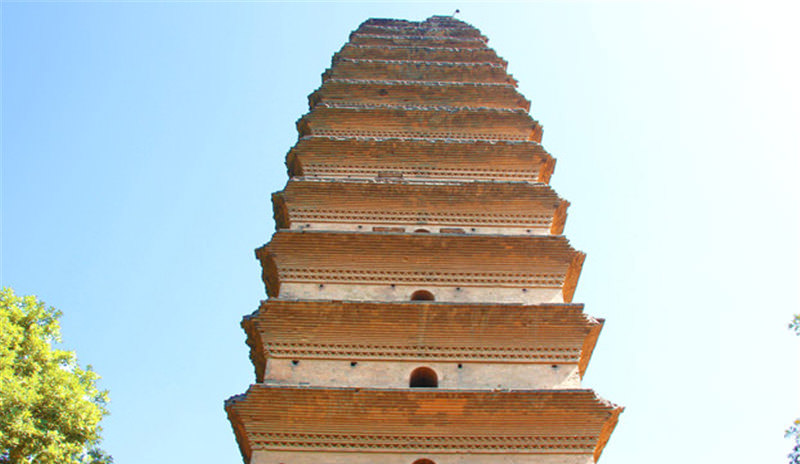 Small Wild Goose Pagoda
Small Wild Goose Pagoda
Entrance is free except during the Chinese Spring Festival when the temple holds its annual fair. Then a charge of around 20-25 RMB / 3-4 USD is levied. Climbing the pagoda does however attract a 30 RMB / 4.3 USD at all times. Opening Times: March 15th to October 31st, 09:00-18:00 (Last tickets at 17:00); November 1-March 14: 09:00-17:30 (Last tickets at 16:30). Closed Tuesdays.
XI'an Ancient City Wall 西安城墙
Xi'an City Wall, sometimes referred to as the Fortifications of Xi'an, is among one of the best-preserved, oldest and largest city walls in China. Built in 1370 by Zhu Yuanzhang, the first Emperor of the Ming dynasty (1368 - 1644), the 14 km / 9 mile rectangular wall completely surrounds the city's downtown area which contains several of Xi'an's best hotels and tourist sites. However, before going inside we should take time to look at the wall itself.
Built as a defensive military wall, featuring battlements, parapets and archery posts etc, the wall is 12 meters / 40 feet tall, 12 to 14 meters / 40 to 46 feet wide at the top and 15 to 18 meters (50 to 60 feet) thick at the bottom. There are now 19 gates (not all open to the public), but it is the 4 main gates, North, South East and West Gates which offer best access and facilities. The South Gate is the most elaborate and so, the most popular choice. Today, visitors can walk around the top of the wall, a trip which takes around 3 to 4 hours and is somewhat strenuous. A popular alternative is to hire a bicycle and cycle around all or part of the wall depending on your energy and interest levels. A full circuit takes between 1½ to 2 hours. The less mobile may prefer to take one of the electric cars which go around the wall in a clockwise direction. The wall does afford great views over both the inner city and the more modern large suburban city outside.
Opening Times: South Gate: 08:00 to 22:00. Other gates: 08:00 to 19:00 from May 1st to Oct 31st; 08:00 to 18:00 the rest of the year. Tickets cost 54 RMB / 7.7 USD
Bike rental: 45 RMB / 6.4 USD for 3 hours, thereafter 5 RMB / 0.7 USD for every additional 10 minutes. Tandem bikes are also available at 90 RMB / 12.8 USD for 2 hours and 10 RMB / 1.4 USD per extra ten minutes, A returnable deposit of 200 RMB /28.5 USD is required. Bikes can be hired at all four main gates and can be returned at any of the gates if you don't want to make a full circuit.
Electric car tours cost 80 RMB / 11.4 USD (standard car) or 120 RMB / 17 USD (luxury car) for a full circuit. Alternatively, you can pay 20 or 30 RMB / 2.9 or 4.3 USD to travel between any two gates.
Bell Tower 西安钟楼
A short walk north from the wall's South Gate, at the center of the old city, is Xi'an Bell Tower, the largest such bell tower in China. Built in 1384, in the Ming dynasty, the Bell Tower was originally used to mark the hours of the day and for making important public announcements. The 36-meter / 118-foot tower was originally situated 1,000 meters (3,280 feet) west of its current position. When first built it was at the exact center of the city, but over time it grew to the east so, in 1582, it was decided to relocate the tower to the new center. The old tower was dismantled and carried to the new site, where it was reassembled on a new base. Today, it is preserved as an important cultural relic and tourist attraction. There is a spiral staircase to the upper reaches, where you can enjoy a panoramic view of the city.
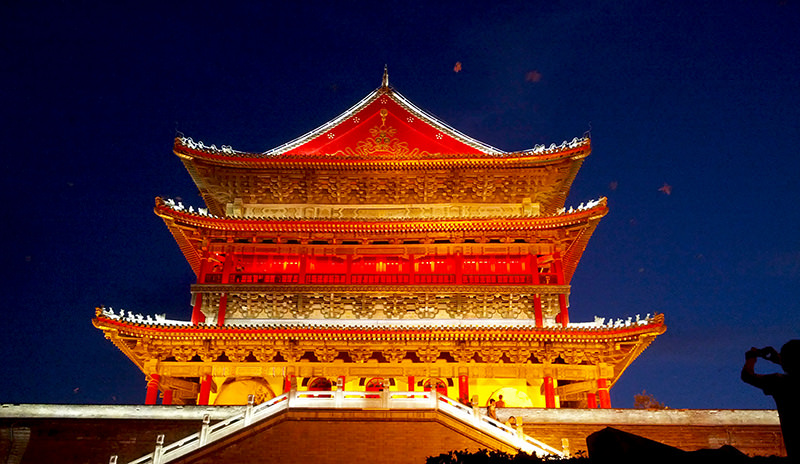 Drum Tower
Drum Tower
The tower is open from 08:30 to 21:00 (last tickets 20:30) from March 26th to October 25th and 08:30 to 18:00 (last tickets 17:30) the rest of the year. Tickets cost 30 RMB / 4.3 USD, but see below. Children under 1.4 meters / 4.6 feet are free if accompanied by an adult.
Drum Tower 西安鼓楼
A short distance from the Bell Tower lies its elder sister, the Drum Tower. This tower, built in 1380, served a similar purpose to the bell tower, marking the time, but also used to warn of danger. Today it is a drum museum and contains the largest drum in China among many others. There are drum performances each day at 09:30, 10:15, 11:00, 11:45, 14:00, 14:45, 15:30 and 16:20.
Open hours and ticket prices are as the Bell Tower. NOTE: A combined ticket for both the Drum and Bell towers is available at either ticket office for 50 RMB / 7.1 USD.
Muslim Quarter 回民街
Adjacent to the Drum Tower is Xi'an's Muslim quarter based around Huimin Street (回民街). The district is home to a tight-knit community of around 20,000 devout Chinese Muslims, mostly of the Hui ethnic minority. It is a great place to just stroll the streets and see a different side of China. One must-see here is the Beiyuanmen (北元门) street market. The shady market street runs north from the Bell Tower for 500 meters / 547 yards and its buildings are modeled on Ming and Qing dynasty styles and contain restaurants and small stores. This is the No. 1 place to sample Xi'an's amazing snacks and cuisine. But more on that to come!
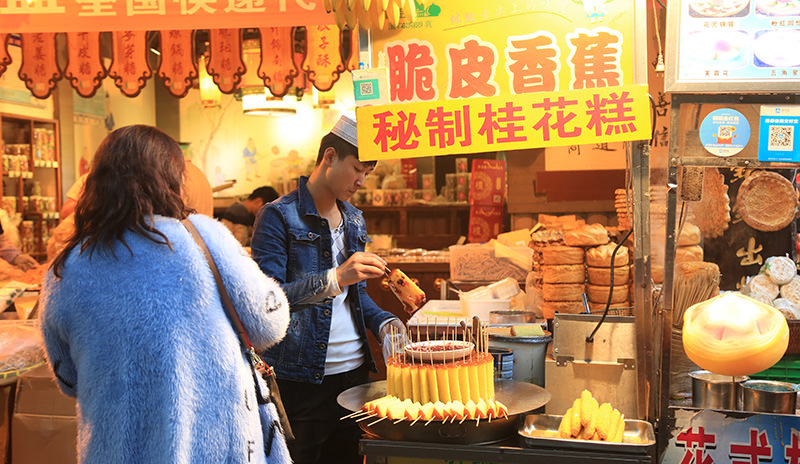 Muslim Street
Muslim Street
Great Mosque 大清真寺
The Muslim Quarter has around ten mosques, but one is very special. The Great Mosque is the largest in China. Covering 12,000 meters²/ 130,000 square feet), the beautiful walled complex, built originally in 742 during the Tang dynasty but reconstructed and enlarged mostly in the Ming Dynasty, today has five courtyards and around 20 buildings.
The mosque is open to the public from 08:00 to 19:00 or sometimes 20:00. Entry to non-Muslim visitors costs 25 RMB / 3.6 USD from March to November; 15 RMB / 2.1 USD at other times. Muslims can enter for free.
Please remember that this is an active place of worship, so appropriate behavior and dress is necessary.
Banpo Neolithic Village Museum 半坡博物馆
If you are interested in China's most distant history, long before emperors ruled, then a side visit to Banpo, a neolithic archaeological site discovered in 1953, is highly recommended. The village, a short way east of Xi'an, has been carbon-dated to around 5,600 to 6,700 years ago and covers an area of 5 to 6 hectares / 21 to 15 acres, surrounded by a ditch which was probably used as a defensive moat. The museum on the site displays tools, artworks, pottery, graves etc and has reconstructions of the neolithic homes of these ancient people.
Opening times: March to November: 08:00 to 18:00; rest of the year 08:00 to 17:30. Admission: March to November: 55 RMB / 7.8 USD; Rest of the year, 40 RMB / 5.7 USD. Children under 1.2 meters / 3.9 feet) free.
Shaanxi History Museum 陕西历史博物馆
Xi'an is the capital of Shaanxi province (陕西), and the city's history museum is one of the largest and best in China. Situated near the Great Wild Goose Pagoda, the museum has a collection of over 370,000 artifacts from the city and province's long, fascinating history. Opened in 1991, the Tang dynasty-style museum buildings can show you the story of Xi'an and Shaanxi starting from prehistoric times over a million years ago right up to the 21st century.
The museum is open Tuesday to Sunday from 08:30 to 18:00 from March 15th to November 14th; 09:00 to 17:30 at other times. It is closed on Mondays, except during public holidays. Entry is not permitted during the last half hour of opening times.
The museum gives out 6,000 free tickets a day (3,000 in the morning and the same again in the afternoon). You will have to show your passport at the ticket office to get a ticket. The Exhibition Hall for Treasures of the Great Tang Dynasty attracts a supplementary cost of 30 RMB / 4.3 USD.
Warning: The museum is particularly crowded during July and August; the school's out for summer and many parents like to drag their children there for a bit of culture! You may wish to avoid it!
Xi'an has many more specialties for you to try and sites to see, but I am out of room here. I will return to its wonderful cuisine in a future post. In the meantime, if you want to visit this wonderful city, include it in a more wide-ranging China trip or want to visit any of Odynovo's 80+ other destinations worldwide, just send us a message telling us where and what you want to see, and our travel experts will craft you a unique, customized itinerary within 24 hours at no obligation of your part.
Related Posts You May Like
What Our Clients Say
Explore the latest verified reviews of Odynovo's travel services on Tripadvisor, Google, Trustpilot, Product Review and more trusted platforms.


